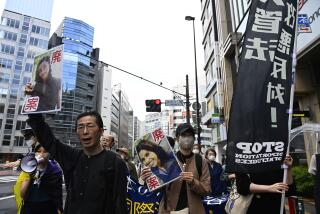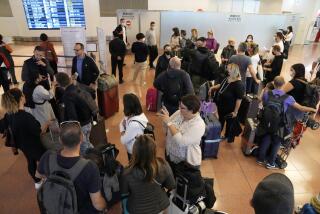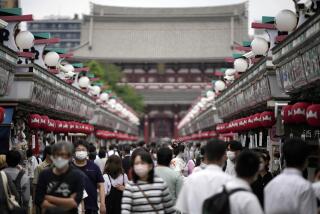COLUMN ONE : Aussies to Say G’Day to Asians : Tourism and investment are pulling Australia into the Pacific’s mainstream. For a culture steeped in Europe, the adjustment hasn’t always been easy.
SYDNEY, Australia — Hiroyuki Sato, a computer systems engineer from Beppu, Japan, decided to honeymoon in Australia because he likes animals and wanted to see kangaroos and koalas. He also thought the country was safe and its food and water sanitary--and he had heard that Australians welcome foreign visitors.
Indeed they do--and among them, Japanese rate among the most favored.
Last year, as 2.25 million foreigners visited the country, tourist revenue reached $5.2 billion, to become Australia’s No. 1 source of foreign exchange--exceeding $4.7 billion worth of wool exports. At the same time, Japanese visitors, who numbered 352,315, surpassed Americans to become second only to New Zealanders.
By the year 2000, about 6.5 million tourists--or four visitors for every 10 Australians--are expected. Among them will be 1.5 million Japanese and as many other Asians, the Australian Tourist Commission predicts. Asians, 22% of the tourists last year, are expected to represent 43% of the visitors by then, the commission said. Qantas, the national airline, foresees a lower figure of 2.5 million Asians but expects about 55% of its global revenue to come from Asia.
The tourist surge, a doubling in the last three years, has come as somewhat of a surprise to Australians.
“Only in the last couple of years has anybody recognized where we are,” said Tony Thirlwell, managing director of the Australian Tourist Commission.
The surge reflects one of the major changes that is sweeping Asia--the expansion of wealthy middle classes not only in Japan but also in Taiwan, South Korea, Hong Kong, Singapore, Malaysia and Thailand that has made the region as a whole the world’s leader in tourism growth.
For Australia, a nation with roots embedded in England and Europe, the growth portends a transformation in both economic and psychological terms.
Australia abandoned an all-white immigration policy in the 1960s and now is significantly populated by a variety of races, many of them Asian.
“No other country in the world has moved so dramatically in immigration as we,” said John Menadue, former head of Qantas, who is now a business consultant. Last year, 57% of new immigrants came from Asia. Yet, Australians remain reluctant to accept a future tied to Asia, he said.
“Australians are still clinging to the past. Whether in the government, in boardrooms or in universities, inertia prevails,” Menadue said.
Prime Minister Bob Hawke, in a dinner speech to a pan-Pacific conference of 12 nations on Asian-Pacific cooperation early this month, acknowledged that Australia, in the past, had “a well-earned reputation for economic and cultural insularity” because of its historical roots in Europe. He said Australians haven’t seen themselves “as an integral part of the (Asia-Pacific) region.”
But he insisted that his government believes that “our future is thoroughly interwoven with that of the Asia-Pacific region.”
Whatever the present consciousness, Menadue said, tourism will drive “Australians, reluctantly, to accept their position in Asia.”
The reason is simple: by 2000, the tourist commission expects tourist expenditures to quadruple to more than $22 billion, excluding the effects of inflation between 1988 and then.
“Tourism is the only identifiable industry that really has a chance of pulling Australia out of its current accounts mire,” said David J. G. Taylor, executive director of the New South Wales Chamber of Commerce and Industry, referring to the nation’s increasing deficit in its trade and nontrade transactions such as insurance, freight and tourism.
Tourism, however, comes with mixed blessings.
For one, it has demonstrated that many Asians are armed with spending power that few Australians--or, for that matter, few persons anywhere--had imagined possible only a few years ago.
“Australians are finding it hard to come to terms with the fact that in our own region, we are relatively poor,” Menadue said.
Some have made the adjustment happily.
The owner of a former Italian restaurant, for example, has transformed his Sydney eatery, the Blue Angel, into a shop specializing in giant lobsters that are cut up for sashimi-- that is, to be eaten raw. The rest of the lobster is baked and diners then pluck cooked meat out of the lobster claws. But so expensive is the delicacy that virtually all customers are now Japanese. With wine, the meal costs about $60 a person, compared with less than $20 a meal that Australians are accustomed to paying at average restaurants.
Honeymooner Sato and a group of nine other couples on a Japan Travel Bureau tour of Sydney, for example, were all prepared to spend the equivalent of $2,140 or more just on souvenirs and gifts. That sum happens to coincide with the limit that the Japanese government places on overseas purchases that can be brought duty-free into Japan.
By comparison, the United States allows its residents to bring home only $400 worth of overseas purchases duty-free.
All 10 couples, who came from points throughout Japan, were staying at the Ramada Renaissance, one of Sydney’s most expensive Japanese-owned hotels. And each of the couples was paying $3,360 for the eight-day honeymoon package that included air fare and lodgings.
Japanese affluence has grown so great that a Japan Travel Bureau survey this fall discovered that 97% of newlyweds booking tours through its offices in Japan were taking overseas honeymoons. In both 1987 and 1988, Australia topped the list of destinations for Japanese honeymooners.
This year, because of prolonged labor turmoil that has crippled all of Australia’s domestic airlines since August--a dispute that still has no end in sight--the country fell to second place, behind Hawaii, as the favorite destination of Japanese newlyweds.
Menadue said that what attracts the Japanese to Australia is “the space--the size--in comparison with their own country. Australia also is safe. We have a drug problem, but nothing on the scale of the United States or Europe. (And) by word of mouth, Japanese learned that Australia is a friendly, open country.”
For their part, there has been Australian concern voiced that some of the tourist developments have injured the environment; even Japanese are worried about a potential for friction in that respect.
“Japanese developers think only of development,” complained Kazuo Wakiyama, managing director of JCT Australia, which handles JAL-PAK tours here.
Recently, stricter controls have been imposed, but “state governments need to come up with long-term visions for tourism” that take the environment into consideration, the Japanese tourism executive said.
Japanese real estate purchases have been even more overwhelming here than in the United States. Investment from Japan is underwriting the bulk of new hotels springing up in Sydney, Brisbane, and Melbourne and is supplying the second-largest amount of money going into tourist development on the Gold Coast, a tourist mecca south of Brisbane. There, New Zealand capital dominates.
“We would like to see Australians invest more in hotels. If the situation is left as it is, economic frictions will develop,” Shunichi Saito, Japan Air Lines’ route marketing director for Asia and Oceania, said in Tokyo.
For Australians, “Japanese investment in hotels and tourist facilities is a new thing,” Menadue said. “Investment that took place earlier in mines and mineral processing was pretty remote from the cities and hasn’t touched many people. But this new phase of relations with Japan is touching people in a very direct way. The novelty and scale of it has caused some concern,” he said.
And some of the Japanese investments have bruised Australian egos--such as the purchase of a koala sanctuary, Menadue added.
Still, he predicted that fears about Japanese investment would die out over time. “Twenty years ago, there was concern about American investment,” he said, noting that those concerns have faded.
But Menadue and others acknowledge that Australian businessmen are “defaulting to the Japanese.”
“Australians have been slow and cautious in investing in their own hotels (because) profit margins are very thin,” he said.
Japanese and Hong Kong Chinese, who also have invested in hotels here, are willing to look at returns over a 20-year to 30-year period, tourist commission director Thirlwell said. In contrast, “a lot of Australians want their return in five years.”
All in all, the tourism potential appears boundless.
With nearly 10 million Japanese overseas travelers expected this year, “we will easily surpass 20 million by 2000,” JAL’s Saito said. “It could even go to 23 million or 25 million.”
Taiwan and South Korea, two newly emerging international tourist giants, neither of which is currently linked to Australia by a direct air route, also offer new horizons for Australia.
To achieve the ambitious goals by 2000 and draw Australia’s targeted share of Japanese global tourists, airport bottlenecks will have to be overcome in both Japan and Australia.
Australia also will have to expand hotel rooms and manpower trained to handle tourists. Hardly any Australians speak Japanese. Skilled guides are insufficient to meet even current demand and must be imported from Japan.
The nation will also will have to recover from its devastating domestic air strike.
Japanese confidence in the Australian tourism market has been shaken, Menadue said, and Australia will have to re-establish a reputation for reliability if it is to persuade agents to continue promoting tours here, he said. The air strike and a letdown after Australia’s bicentennial celebrations last year promise to wipe out growth in Japanese tourism this year.
Wakiyama said Australians are “very hospitable” but often provide poor service by Japanese standards. And although golf courses and yachts abound in Sydney, hardly any are available for tourists, he added.
Travel agents will have to provide a larger “menu” of destinations and more detailed descriptions of what is available to satisfy the growing diversity in Japanese travel tastes, he said.
With overseas travelers about to surpass 10 million a year, Wakiyama said, “international travel is no longer the once-in-a-lifetime experience it once was for Japanese.” Travel styles are changing away from the old “a-sight-a-minute” pattern of group activity, he said. “Some Japanese want to do things by themselves. Others just want to relax.”
Not only tourism but overall relations with Japan can only expand, Menadue said.
“The only question is at what pace they will grow,” he said. “The pace will be determined by the attitudes in Australia.”
But Australians “haven’t got many alternatives,” he said. “They (the Japanese) have the money to invest and the people to travel, and we haven’t.”
More to Read
Sign up for Essential California
The most important California stories and recommendations in your inbox every morning.
You may occasionally receive promotional content from the Los Angeles Times.










